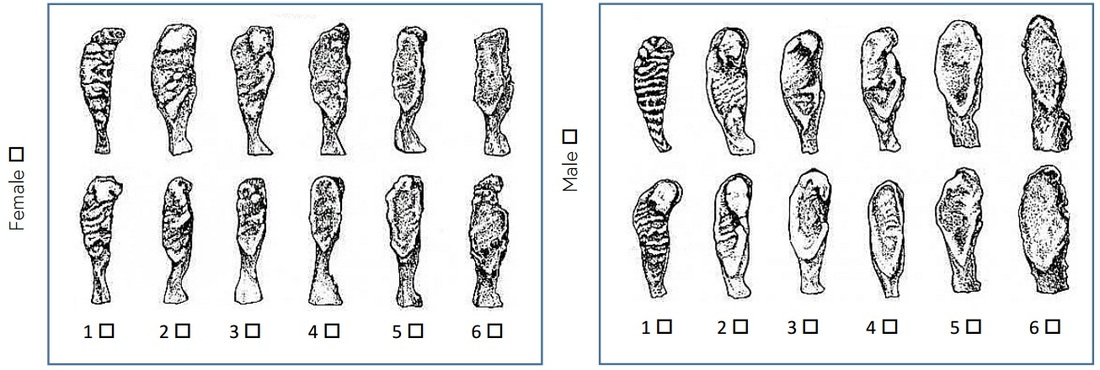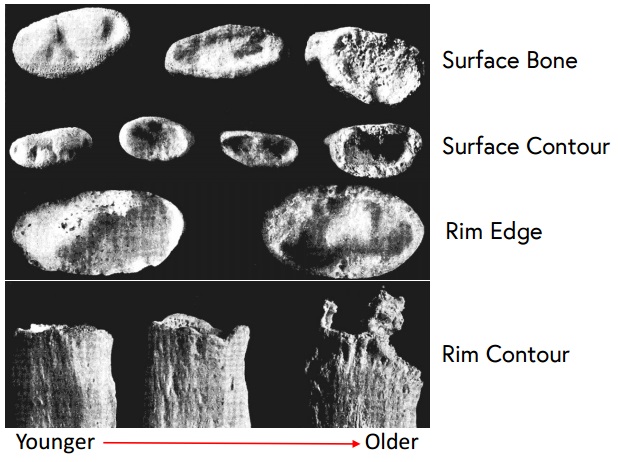This week had more hands on activities for the class. One of them was to look over the victim profile and deduce from the skeleton if they were female or male. Now, in a previous blog I covered sexing: http://anthropologicalconcepts.weebly.com/blog/male-or-female. But we covered something that I have been wanting to speak of, and that something is aging. Before I have covered the aging process and what the human body goes through as it gets older, but this type of aging happens after death.
If the victim still has skin and clothes, they can profile and get a photo out to the public, and most likely will get someone who knows them. But what happens when all you have are bones? There are 3 bones that forensic anthropologists rely on when aging a body. These are the skull, the clavicle, the pubis, and the sternal end of the 4th rib.
For the skull, they look for the joints called cranial sutures. What these are are the areas of the skull that have joined together. The more open the sutures, the younger the victim. These sutures have a time table that forensic anthropologist can estimate how old a victim was. These sutures do not close all the way til about the age of 20 or 21. Now just because they close at that age does not mean it ends there. As they age, the sutures begin to fuse. The less the fusion, the younger the victim.
The clavicle (collar bone), aging has to with the fusion. Certain bones have several parts until we reach adult hood. We go from 300 as babies to 206 as adults. Now just because many of our bones have certain fusing timetables, forensic anthropologists use the clavicle because this one is the last to fuse to the main shaft. If the clavicle has no flaking on the surface of the bone, this means the victim is younger than 18 years old. If it has a flake of the bone is beginning to fuse, the age range the victim is put at is 15-21 years old. After the flake has completely fused this is categorized as between 24 and 29 years old.
If the victim still has skin and clothes, they can profile and get a photo out to the public, and most likely will get someone who knows them. But what happens when all you have are bones? There are 3 bones that forensic anthropologists rely on when aging a body. These are the skull, the clavicle, the pubis, and the sternal end of the 4th rib.
For the skull, they look for the joints called cranial sutures. What these are are the areas of the skull that have joined together. The more open the sutures, the younger the victim. These sutures have a time table that forensic anthropologist can estimate how old a victim was. These sutures do not close all the way til about the age of 20 or 21. Now just because they close at that age does not mean it ends there. As they age, the sutures begin to fuse. The less the fusion, the younger the victim.
The clavicle (collar bone), aging has to with the fusion. Certain bones have several parts until we reach adult hood. We go from 300 as babies to 206 as adults. Now just because many of our bones have certain fusing timetables, forensic anthropologists use the clavicle because this one is the last to fuse to the main shaft. If the clavicle has no flaking on the surface of the bone, this means the victim is younger than 18 years old. If it has a flake of the bone is beginning to fuse, the age range the victim is put at is 15-21 years old. After the flake has completely fused this is categorized as between 24 and 29 years old.
Now I am sure you are thinking, what if the victim is older than 29? This is where looking at the pubis comes in handy. Below is a picture of a pelvis, the area circled in red is the area forensic anthropologists use for this method of aging. They use the area where the pubis come together, so they really just need one of the pubis. This area varies very drastically throughout the time when you age. The image below the one of the pelvis is a diagram they use when aging a pubis; the reason there are two images of each is to show how much of a variation that might occur. As you can see, on the first column, it is very bumpy and rough. But as you progress looking further to the right it begins to get smoother and more pitted; this is due to degeneration. The one with “1” under it is for the 95% age range of 15-24, while on the one with “6” the age range changes to 42-87. The reason for the huge age gap is because it gets harder to pinpoint how old the victim is.
This brings us to the sternal (area of the rib that connects to the sternum) end of the 4th rib. The reason they use the 4th rib is because that is the rib the method of looking for age using the rib was started by looking at the 4th rib. The differences they look for lie in the surface of the bone, the surface contour, rim edge, and the rim contour (image below). These, unlike the pubis, have a smaller age range of 10 years (image below).
Next week we have a forensic facial reconstruction, which is a powerful technique which can aid in establishing the identity of the deceased. With two weeks left, I am sad to see this journey come to end...but it is not done yet!
Please feel free to comment on what you thought of the blog, or other physical anthropological subjects you would like me to cover after the weeks are done.
Please feel free to comment on what you thought of the blog, or other physical anthropological subjects you would like me to cover after the weeks are done.





 RSS Feed
RSS Feed
